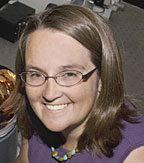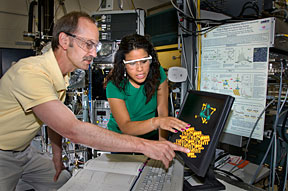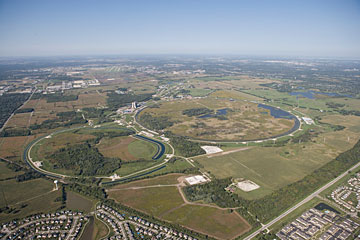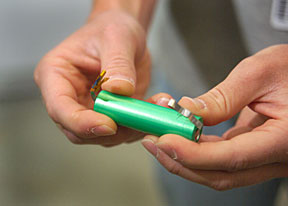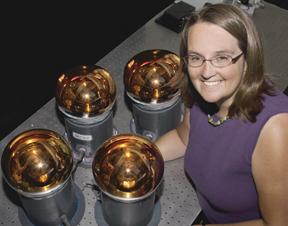| Research
|
Brenda Dingus of DOE's Los Alamos National Laboratory likes to live on the edge—in scientific theory, that is. “Gamma-ray astronomy allows us to look at the sky in a way that pushes our theories of physics to the limits,” she said. Recognized for her involvement in large-scale projects such as the Laboratory’s Milagro Observatory at Fenton Hill and the High Altitude Water Cherenkov (HAWC) telescope at Volcàn Sierra Negra, Mexico; her collaboration with international physicists; and teaching astronomy at the Universities of Wisconsin and Utah, Dingus was named a 2008 LANL Star by the Women’s Diversity Working Group. Submitted by DOE's Los Alamos National Laboratory |
|||||||||||||||||||||||||||||
|
Check out the joint Fermilab/SLAC publication symmetry.
|
PNNL streamlines
|
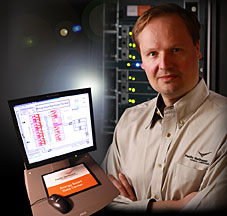 |
| Andres Marquez leads the PNNL Energy Efficient Data Center team that is finding ways to cut energy use while boosting supercomputer performance. |
In a room the size of a garage, two rows of six-foot-tall racks holding supercomputer equipment sit back-to-back. Thin tubes and wires snake off the servers, slithering into the corners. Stepping between the rows, a rush of heat whips around you — the air from fans blowing off processing heat.
But walk farther in, between the next racks of servers, and the temperature drops noticeably. These servers are being cooled by a liquid that runs right over the hardworking processors. The liquid carries the heat away in tubes, reducing the strain on air-cooling.
This is the Energy Smart Data Center at Pacific Northwest National Laboratory. The bigger, faster and meatier supercomputers get, the more energy they consume. PNNL's Andres Marquez and his team have developed this test bed to learn how to train the behemoths in energy efficiency.
The work will help supercomputers perform better as well. Processors have to keep cool or suffer from "thermal throttling," says Marquez. "That's the threshold where the processor is too hot to operate safely, reduces processing capabilities and might result in worse performance."
The center at EMSL, DOE's national scientific user facility at PNNL, harbors several ways of experimenting with energy usage. For example, the center has its own air- and liquid-cooling systems that can be controlled independently from the rest of EMSL. Pipes running beneath the floor carry temperature-controlled water through the center’s own heat exchangers to the supercomputer. The center developed its own software called FRED – Fundamental Research for Efficient Datacenters – to address the difficulty of monitoring over the various scales of the whole cooling infrastructure – from the chip, to the heat-exchangers, pumps, chillers and water towers.
"With this center we can test under real-world conditions whether it's more energy efficient to cool directly on the processing chips, possibly bypassing the chillers, or if a traditionally optimized air-cooled infrastructure still comes out ahead. Other aspects such as reliability, maintainability and total cost of ownership are evaluated as well," says Marquez.
Marquez's group is also developing "power aware computing," where the computer programs themselves perform calculations more energy efficiently. Maybe once computers get smart about energy, they'll have tips for their users.”
Submitted by DOE's Pacific Northwest National Laboratory
